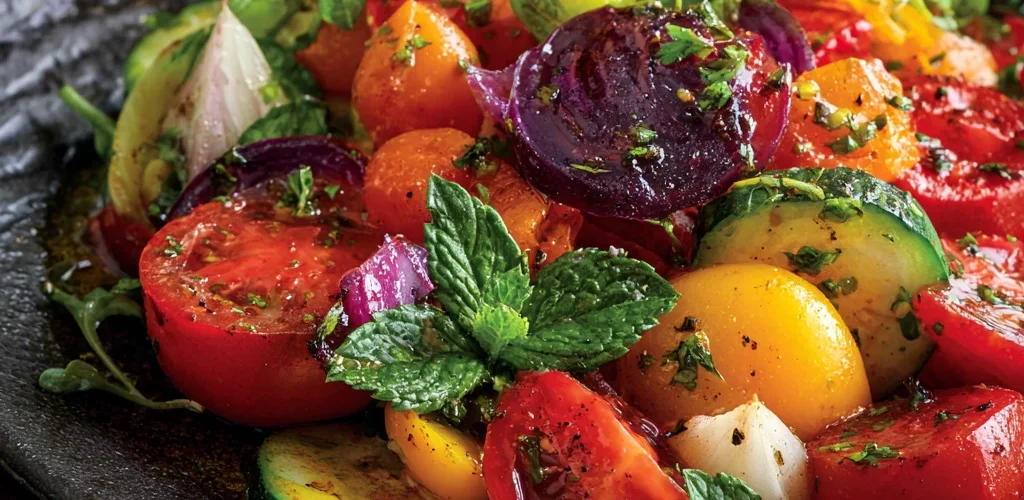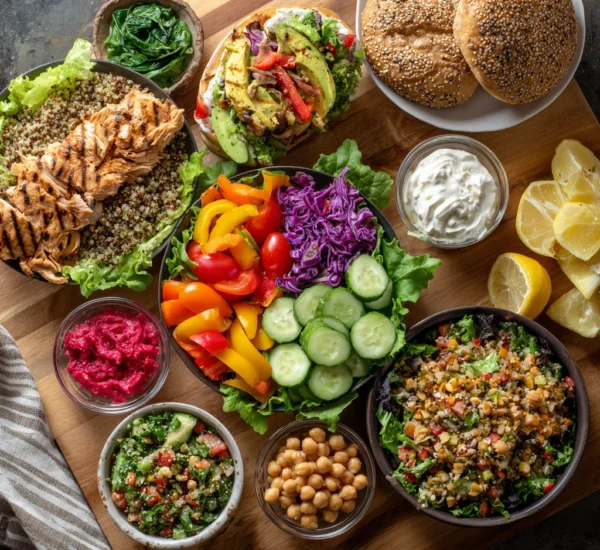Garden Vegetable Recipes Full of Flavor
Summer’s bounty is a gift. A garden overflowing with fresh vegetables provides the perfect opportunity to create flavorful, healthy meals. But transforming those vibrant ingredients into truly delicious dishes requires more than just throwing them together. This article explores ten garden vegetable recipes that are packed with flavor, offering tips and techniques to elevate your cooking and make the most of your harvest.
Section 1: Mastering the Art of Garden Vegetable Flavor
Before diving into specific recipes, it’s crucial to understand the principles behind maximizing flavor in vegetable dishes. The key lies in proper preparation, cooking techniques, and the strategic use of herbs, spices, and other flavor enhancers.
Selecting the Freshest Ingredients
The foundation of any great vegetable dish is, of course, the quality of the vegetables themselves. Choose produce that is ripe, firm, and free from blemishes. Ideally, harvest your vegetables shortly before cooking to retain their peak flavor and nutritional value. For store-bought vegetables, look for vibrant colors and a fresh, clean scent.
Enhancing Flavor Through Cooking Techniques
Certain cooking methods are better suited for bringing out the best in different vegetables. Roasting intensifies sweetness and caramelizes natural sugars, making it ideal for root vegetables like carrots and potatoes, as well as cruciferous vegetables like broccoli and Brussels sprouts. Sautéing and stir-frying allow for quick cooking, preserving the crisp-tender texture of vegetables like peppers, zucchini, and green beans. Grilling imparts a smoky char that adds depth of flavor to almost any vegetable. Steaming and blanching are gentler methods that retain nutrients and vibrant colors, making them suitable for delicate vegetables like asparagus and spinach.
The Power of Herbs, Spices, and Aromatics
Don’t underestimate the impact of herbs, spices, and aromatics. Fresh herbs like basil, oregano, thyme, and parsley can brighten and enhance the natural flavors of vegetables. Spices like cumin, coriander, chili powder, and smoked paprika can add warmth, depth, and complexity. Aromatics like garlic, onions, and shallots provide a savory base note that complements a wide range of vegetables. Experiment with different combinations to find your favorites.
Adding Acidity and Fat
Acidity and fat are two crucial elements for balancing and rounding out the flavors of vegetable dishes. A squeeze of lemon juice or a splash of vinegar can brighten the flavors and cut through richness. Adding healthy fats like olive oil, avocado, or nuts provides richness and satiety. Don’t be afraid to experiment with different vinegars, like balsamic, apple cider, or red wine vinegar.
Section 2: Garden Tomato Extravaganza
Tomatoes are a quintessential garden vegetable, versatile enough for salads, sauces, and everything in between. These recipes showcase the incredible flavor of fresh, ripe tomatoes.
Burst Tomato Pasta
This simple yet incredibly flavorful pasta dish relies on the natural sweetness and acidity of cherry or grape tomatoes. Sauté garlic in olive oil, then add the tomatoes and cook until they burst and release their juices. Toss with cooked pasta, fresh basil, and a generous grating of Parmesan cheese. A sprinkle of red pepper flakes adds a touch of heat. The key is to use high-quality olive oil and fresh, flavorful tomatoes.
Tomato and Basil Bruschetta
Classic bruschetta is a celebration of fresh ingredients. Toast slices of crusty bread and rub them with garlic. Top with a mixture of diced tomatoes, fresh basil, olive oil, balsamic vinegar, and a pinch of salt and pepper. The sweetness of the tomatoes, the herbaceousness of the basil, and the tang of the balsamic vinegar create a perfect balance of flavors. For an extra layer of flavor, add a sprinkle of crumbled feta cheese or a drizzle of balsamic glaze.
Roasted Tomato Soup
Roasting tomatoes intensifies their sweetness and creates a rich, flavorful base for soup. Toss halved tomatoes with olive oil, garlic, herbs (such as thyme and oregano), and a pinch of salt and pepper. Roast until softened and slightly caramelized. Blend the roasted tomatoes with vegetable broth until smooth. Season to taste and serve with a swirl of cream or a dollop of pesto. For a heartier soup, add roasted red peppers or butternut squash to the mix.
Section 3: Zucchini – More Than Just Bread
Zucchini is often relegated to zucchini bread, but this versatile vegetable can be used in so many other delicious ways. These recipes highlight the versatility of zucchini.
Grilled Zucchini with Lemon-Herb Dressing
Grilling zucchini imparts a smoky char that complements its mild flavor. Slice zucchini lengthwise into planks and brush with olive oil. Grill until tender and slightly charred. Whisk together lemon juice, olive oil, minced garlic, fresh herbs (such as parsley, dill, and mint), and a pinch of salt and pepper. Drizzle the dressing over the grilled zucchini. A sprinkle of toasted pine nuts adds a nice textural contrast.
Zucchini Noodles with Pesto
Zucchini noodles, or “zoodles,” are a healthy and delicious alternative to pasta. Spiralize zucchini into noodles. Toss with pesto (homemade or store-bought), cherry tomatoes, and Parmesan cheese. You can also add grilled chicken or shrimp for a more substantial meal. For a vegan option, use a cashew-based pesto. Gently sauté the zoodles for a minute or two to soften them slightly.
Stuffed Zucchini Boats
Halve zucchini lengthwise and scoop out the flesh. Sauté the zucchini flesh with onions, garlic, and other vegetables (such as bell peppers and mushrooms). Mix with cooked rice or quinoa, herbs, spices, and cheese. Stuff the zucchini boats with the mixture and bake until tender. You can customize the filling with different vegetables, cheeses, and proteins to create a variety of flavor combinations.
Section 4: Peppers – Sweet, Spicy, and Everything In Between
Bell peppers, chili peppers, and everything in between add vibrant color and flavor to a wide range of dishes. These recipes showcase the versatility of peppers.
Stuffed Bell Peppers
Cut the tops off bell peppers and remove the seeds. Sauté ground meat (such as beef, turkey, or sausage) with onions, garlic, and rice. Mix with diced tomatoes, tomato sauce, herbs, and spices. Stuff the bell peppers with the mixture and bake until tender. You can also make vegetarian stuffed peppers using lentils, quinoa, or beans as the base of the filling. Add a sprinkle of cheese on top for a golden-brown finish.
Roasted Red Pepper Dip
Roast red bell peppers until the skin is blackened. Place them in a bowl and cover with plastic wrap to steam. Peel off the skin, remove the seeds, and blend the roasted peppers with garlic, lemon juice, tahini, olive oil, and spices (such as cumin and paprika). Serve with pita bread, vegetables, or crackers. This dip is a flavorful and healthy alternative to hummus.
Spicy Chili
Chili is a hearty and comforting dish that can be customized with different types of beans, vegetables, and spices. Sauté onions, garlic, and chili peppers (such as jalapeños or serranos) in a large pot. Add ground meat or beans, diced tomatoes, tomato sauce, and spices (such as chili powder, cumin, and oregano). Simmer until the flavors have melded. Serve with your favorite toppings, such as shredded cheese, sour cream, avocado, and cilantro.
Section 5: Root Vegetables – Earthy Delights
Root vegetables like carrots, potatoes, beets, and parsnips are often overlooked, but they are packed with flavor and nutrients. These recipes celebrate the earthy sweetness of root vegetables.
Roasted Root Vegetables with Herbs
Toss cubed root vegetables (such as carrots, potatoes, beets, and parsnips) with olive oil, herbs (such as rosemary, thyme, and sage), and a pinch of salt and pepper. Roast until tender and slightly caramelized. Roasting brings out the natural sweetness of the vegetables and creates a delicious side dish. A drizzle of balsamic glaze adds a touch of acidity and sweetness.
Carrot and Ginger Soup
Sauté onions, garlic, and ginger in a pot. Add sliced carrots and vegetable broth. Simmer until the carrots are tender. Blend the soup until smooth. Season to taste and serve with a swirl of coconut milk or a dollop of yogurt. Ginger adds a warming and spicy flavor to the sweetness of the carrots.
Beet and Goat Cheese Salad
Roast or boil beets until tender. Peel and slice the beets. Arrange the beets on a plate with crumbled goat cheese, walnuts, and mixed greens. Drizzle with balsamic vinaigrette. The earthy sweetness of the beets pairs perfectly with the tangy goat cheese and crunchy walnuts.
FAQ: Garden Vegetable Recipes
Q: How can I make my vegetable dishes more flavorful?
A: Use fresh, high-quality vegetables, experiment with different cooking techniques, and don’t be afraid to use herbs, spices, and aromatics. Adding acidity and fat can also help balance and round out the flavors.
Q: What are some easy ways to use up excess garden vegetables?
A: Make soups, stews, stir-fries, or salads. You can also pickle or ferment vegetables to preserve them for later use. Zucchini bread and tomato sauce are also great options for using up excess produce.
Q: Can I freeze garden vegetables?
A: Yes, many garden vegetables can be frozen. Blanch vegetables before freezing to preserve their color and texture. Store frozen vegetables in airtight containers or freezer bags.
Q: What are some good herbs to grow in a vegetable garden?
A: Basil, oregano, thyme, parsley, rosemary, and mint are all great herbs to grow in a vegetable garden. They are easy to grow and can be used in a wide variety of dishes.
Q: How do I prevent my vegetables from becoming soggy when roasting?
A: Make sure to preheat your oven to a high temperature. Toss the vegetables with enough olive oil to coat them evenly. Don’t overcrowd the baking sheet, as this will cause the vegetables to steam instead of roast.



